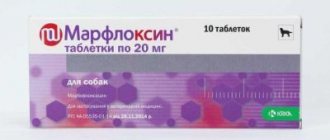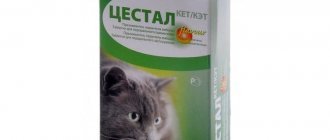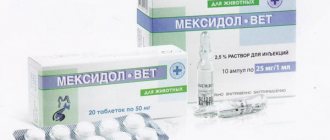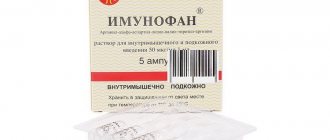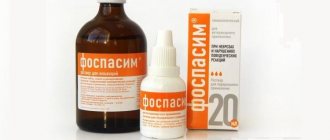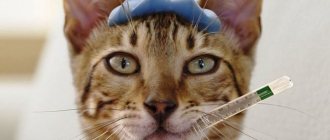Dosage form and composition
Marfloxin is one of the few antibiotics that are available in tablet form. The drug is also produced in the form of an injection solution, but is usually not used to treat dogs, since it was originally intended for calves and pigs.
The main (active) component of the drug is marbofloxacin. In addition to a substance that can destroy harmful bacteria, the composition includes:
- meat flavoring;
- lactose monohydrate;
- magnesium stearate and other auxiliary components.
Be careful when purchasing the tablets as they come in three different varieties. The active substance content can be 5, 20 or 80 mg. The latter option is used only when treating large breed dogs, since for small animals it is very difficult to correctly calculate the dose.
They are packaged in blisters and then packed into cardboard boxes. Their number may vary. The antibacterial agent can only be stored in its original packaging, and the air temperature should be between 0 and 25˚C. To prevent the drug from losing its pharmacological properties, you need to select a dry place protected from ultraviolet radiation for storage.
What is Marfloxin
The drug Marfloxin is available in the form of tablets and solution for injection. The active ingredient for both types of medication is marbofloxacin. Additionally, the tablets include:
- lactose monohydrate;
- povidone;
- crospovidone;
- magnesium stearate;
- meat flavoring;
- hydrogenated castor oil;
- yeast powder;
- colloidal anhydrous silicon dioxide.
Marfloxin is available for both cats and dogs
Auxiliary components for the solution:
- gluconolactone;
- disodium edetate;
- mannitol;
- metacresol;
- monothioglycerol;
- water for injections.
Marfloxin solution is administered by injection
The tablets can be used for two years from the date of manufacture. This form can be stored at a temperature not lower than zero and not higher than 25 degrees. Tablets should not be left near heat sources, nor should they be kept with food or in a place accessible to children and other pets.
The solution should be used within three years from the date of manufacture. An open ampoule should be stored for no more than 28 days. Freezing the solution is prohibited, otherwise it will lose its properties. Optimal storage conditions are from 5 to 25 degrees in a dry and dark place.
Attention! The veterinarian determines which form of the drug to use after making a diagnosis. Treating your pet on your own is extremely dangerous and can lead to complications.
Action
Marfloxin has a wide spectrum of antibacterial action. The active substance is active against various microorganisms. The medicine is effective against the following pathogens:
- proteas;
- Haemophilus influenzae;
- coli;
- Brucella;
- Citrobacter;
- salmonella;
- staphylococcus;
- mycoplasma;
- streptococcus;
- enterobacter, etc.
The principle of action of marbofloxacin, which belongs to the group of fluoroquinolones, is that it interferes with the release of enzymes necessary for the synthesis of bacterial DNA. As a result of this impact, their reproduction stops.
If Marfloxin tablets for dogs are used, the active substance is easily absorbed in the intestine. After this, it penetrates the blood and spreads throughout the body. Helps destroy bacteria regardless of the location of the disease. The bioavailability of the drug is 100%. In other words, every milligram of marbofloxacin affects harmful microorganisms.
The active substance is not metabolized in the body, therefore it is excreted unchanged, mainly in urine, partly in bile. The maximum concentration in the blood reaches 2 hours after administration.
Indications and instructions for use
According to the instructions, Marfloxin for dogs is prescribed for diseases of a bacterial nature:
- kidneys and genitourinary system;
- gastrointestinal tract;
- respiratory organs.
The antibiotic is also used in the treatment of otitis media, infectious wounds and skin lesions that manifest as purulent inflammation. The medicine is no less effective for fungal pathologies. The drug can also be used to treat other pathologies if their pathogens are sensitive to the active substance.
Give the medicine to dogs once a day. The dose depends on weight. For every kilogram of mass you need 2 mg of the active substance. For example, one 20 mg tablet is designed for an animal weighing 10 kg. To avoid overdose, when purchasing a medicine, pay attention to its concentration.
Despite the fact that the composition includes meat flavoring, most dogs refuse to voluntarily eat the tablets in their pure form. You can give them to your pet in two ways:
- Crush into powder and mix with a small amount of food. It is better to choose the animal's favorite treat.
- Mix the pre-crushed medication in water or milk and give the animal a drink.
- Forcefully place the tablet on the root of the tongue. This method is used for pets who refuse to take medicine mixed with food. An introducer, a special device, will help simplify the task.
The duration of treatment depends on the pathology:
- for infectious lesions of soft tissues and skin – from 5 to 40 days;
- for respiratory diseases (bronchitis, tracheitis, laryngitis, etc.) – from 1 to 3 weeks;
- for diseases of the genitourinary system - from 10 to 28 days.
The duration of the course is determined by the doctor depending on the symptoms, severity of the disease, and the presence of complications.
It is not recommended to skip medication. The consequence may be a decrease in the effectiveness of the drug. If it was not possible to avoid skipping, treatment should be resumed as soon as possible in doses prescribed by the doctor. There is no need to increase the dose, as this may lead to an overdose.
Analogues of the veterinary drug Marfloxin
Synonyms for Marfloxin according to indications for use are other antibacterial drugs produced in different countries: Baytril, Amoxicillin, Ciprovet, Gentamicin, etc.
Comparison table: analogues of Marfloxin
| Name | Manufacturer | Dosage form | Composition of the analogue (1 ml) | Contraindications | Side effects | Use for kittens | Use for pregnant and lactating cats | Price |
| Baytril 2.5% | Bayer Animal Health (Germany) | Solution for injection (sometimes for drinking) |
|
| Allergy to components | After growth ends | It is forbidden | From 300 rubles (100 ml) |
| Amoxicillin | Hemofarm (Serbia), Invesa (Spain), “Biopreparat”, “Biokhimik (Russia), etc. | Tablets, powder, suspension for administration into a muscle or under the skin | Pills:
Suspension:
|
|
| Rarely (by injection) | Not recommended (but practiced) | From 200 rubles (10 ml) |
| Tsiprovet | "Agrovetzashchita" (Russia) | Tablets, drops for eye drops | Solution:
|
|
| From 1 week (tablets are not allowed until growth is complete) | It is forbidden | From 140 rubles (10 tablets) |
| Gentamicin | "Agropharm" (Russia), Polfa (Poland), Agio Pharmaceuticals (India), etc. | Solution for injection into muscle |
|
|
| Weighing from 1 kg | It is forbidden | From 35 rubles (2 ml) |
Photo gallery: analogues of Marfloxin
Baytril 2.5% in terms of the degree of impact on the body is classified as a moderately hazardous substance; in recommended doses it is well tolerated by cats Amoxicillin is a 4-hydroxyl analogue of ampicillin that has a bactericidal effect
Ciprofloxacin hydrochloride, which is part of the drug, has a bactericidal effect on most gram-positive and gram-negative microorganisms. Some veterinarians administer Gentamicin to a cat intravenously using a catheter (but this is difficult to do on your own)
Contraindications
The instructions for use contain information that Marfloxin cannot be used for dogs with individual intolerance to the components. You should also not use it:
- for puppies up to 12 months of age (cannot be used for large breed puppies up to 18 months of age);
- during pregnancy;
- during lactation.
This is due to the fact that the drug can negatively affect the development of the bone apparatus. Diseases of the nervous system are also contraindications.
Note! The simultaneous use of antibiotics with medications that contain iron, calcium, magnesium and other macro- and microelements is not recommended. Marbofloxacin reduces the absorption of minerals, which means the effectiveness of these medications decreases.
Marfloxin should not be used together with tetracycline or macrolide antibacterial agents, chloramphenicol.
Medicines similar in mechanism of action - table
| Name | Release form | Active ingredient | Indications | Contraindications | Adverse reactions | Can it be used to treat pregnant cats? | Price |
| Amoxicillin |
| amoxicillin | Infectious diseases of the gastrointestinal tract, genitourinary system, as well as lesions of soft tissues. |
|
| No. | From 42 rub. |
| Gentamicin |
| gentamicin | Elimination of bacterial infections affecting the skin, genitourinary system and organs of vision. |
|
| No. | From 30 rub. |
| Tsiprovet |
| ciprofloxacin hydrochloride | Elimination of inflammatory diseases of the gastrointestinal tract, respiratory system, genitourinary system, soft tissues and skin of bacterial etiology. |
|
| No. | From 160 rub. |
Medicines with similar effects - photo gallery
Amoxicillin is used to treat cats and dogs
Tsiprovet is prohibited during pregnancy and lactation
Gentamicin eliminates a wide range of microorganisms
Marfloxin is an antibacterial drug that has a positive effect on a number of infectious diseases. This medicine helps your pet recover quickly, avoiding unwanted consequences. However, despite the advantages of the medication, the presence of contraindications and side effects should be taken into account.
What side effects might there be?
If the dose is not exceeded, the medication is well tolerated by animals and does not cause side effects. Sometimes minor disturbances from the gastrointestinal tract may appear. They manifest themselves as vomiting or diarrhea. There is no need to stop taking the antibiotic if the animal’s condition does not worsen. Symptoms go away on their own after completing the course of treatment.
In case of an overdose, disruptions in the functioning of the nervous system may occur. In this case, you should seek help from a veterinarian. He will prescribe symptomatic treatment.
Other antibiotics
- Trichopol (Trichopol) for cats (veterinary instructions for use, doses, indications and contraindications)
- Instructions for use of ceftriaxone for cats
- Instructions for use of Metrogyl for cats. Explore the breadth of Metrogyl's antibacterial effect
- Instructions for use of doxycycline for cats. Explore the breadth of antibacterial effects of doxycycline in cats
- Instructions for use of clindamycin for cats (Clindamycinum). Explore the breadth of the antibacterial effect of clindamycin in cats
- Instructions for use of metronidazole for cats (Metronidazole)
- Doxifin for cats (instructions for use, doses, indications and contraindications)
- Atovaquone (ATOVAQUONE)
- Azithromycin for cats (instructions)
Signs of toxicity/overdose
An overdose of marbofloxacin can lead to:
- Lack/loss of appetite
- Vomiting
- Diarrhea
- Dizziness
- Dilated pupils or blindness (in cats)
- Seizures
If you suspect or know that your dog or cat has overdosed, please contact your veterinarian or 24-hour veterinary clinic immediately.
Literature
- Albarellos GA et al. Pharmacokinetics of marbofloxacin after single intravenous and repeat oral administration to cats // Vet. J. – 2005. – Vol. 170(2). – P. 222-229.
- Biswas S. et al. Molecular mechanisms of Bartonella henselae resistance to azithromycin, pradofloxacin and enrofloxacin // J. Antimicrob. Chemother. – 2010. – Vol. 65(3). – P. 581-582.
- Farca AM et al. In vitro antimicrobial activity of marbofloxacin and enrofloxacin against bacterial strains isolated from companion animals // Schweiz. Arch. Tierheilkd. – 2007. – Vol. 149(6). – P. 265-271.
- Ishak AM et al. Marbofloxacin for the treatment of experimentally induced Mycoplasma haemofelis infection in cats // J. Vet. Intern. Med. – 2008. – Vol. 22(2). – P. 288-292.
- Litster A. et al. Clinical efficacy and palatability of pradofloxacin 2.5% oral suspension for the treatment of bacterial lower urinary tract infections in cats // J. Vet. Intern. Med. - 2007. - 21(5). – P. 990-995.
- Spindel ME et al. Evaluation of pradofloxacin for the treatment of feline rhinitis // J. Feline. Med. Surg. - 2008. – Vol. 10(5). – P. 472-479.
- Tasker S. et al. Effect of chronic FIV infection, and efficacy of marbofloxacin treatment, on Mycoplasma haemofelis infection // Vet. Microbiol. – 2006. – Vol. 117(2-4). – P.169-179.
^Top
Undeniable advantages
The main advantages of Marfloxin include:
- Safety. Does not contain toxic compounds. According to GOST, it is classified as a low-hazard substance.
- Convenient dosage form - tablets. Many dog owners do not know how or are afraid to give injections.
- Easy to store. The drug does not require special storage conditions. You can store the medicine at room temperature, for example, in a kitchen cabinet.
- Wide spectrum of action. Effective against various harmful bacteria, suitable for the treatment of pathologies of the gastrointestinal tract, respiratory and genitourinary systems, and inflammation of soft tissues.
The advantages include convenient use - it is easy to choose a drug for large and small animals, as it is available in different concentrations.
Pregnant, lactating and puppies
Fluoroquinolone drugs are not given to puppies unless they are 12 months old. Large pets are prescribed medication after 18 months. The drug is not used in pregnant women, or during breastfeeding. Antibiotics should not be prescribed to animals with central nervous system diseases or allergic pathologies.
The use of Marfloxin in a pregnant bitch can lead to miscarriage. A pet awaiting the birth of offspring often experiences loss of appetite, abdominal pain, nausea and vomiting, and changes in liver function indicators. In small puppies under 1 year of age, reactions from the central nervous system may occur:
- insomnia;
- weaknesses;
- increased excitability;
- seizures
Owner reviews
Oksana, owner of a Labrador:
“When my handsome dog got sick with a cold, he was prescribed antibiotics. I’m terribly afraid to give injections, so the veterinarian recommended Marfloxin tablets. The dog recovered quickly. True, he refused to eat the pills; he had to crush them and mix them with his favorite milk. We took the medicine for a week, there were no side effects. I was satisfied with the treatment process and the result.”
Olga, Pekingese owner:
“During an exacerbation of urolithiasis in our dog, the doctor prescribed this antibiotic. Elsa spat out the tablets, so she had to mix them into canned food. During the entire period of treatment (3 weeks) there was never any vomiting or diarrhea, but after the course the test results returned to normal, and the dog stopped being in pain.”
Victoria, pinscher owner:
“We were prescribed a course of Marfloxin for the treatment of cystitis. The drug helped cope with the disease. After a while, however, I had to have an operation, but this had nothing to do with the medicine. The medicine performed its functions perfectly, although our dog did not like it.”
